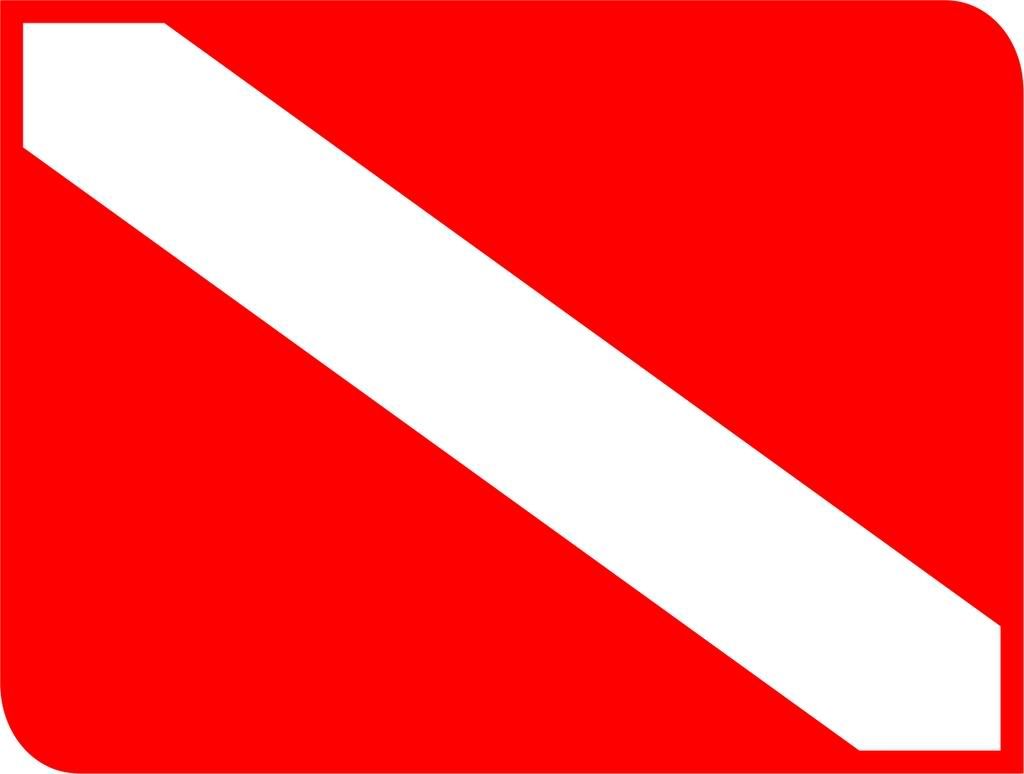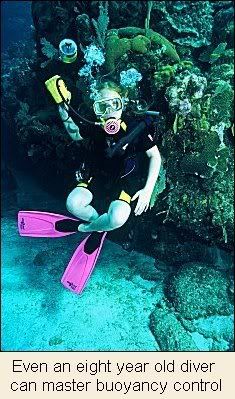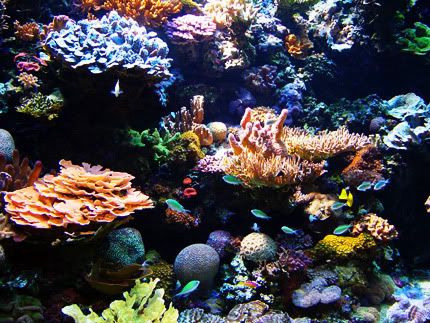 Scuba diving is swimming underwater while using self-contained breathing equipment. By carrying a source of compressed air with him, the scuba diver is able to stay underwater longer than he can with the simple breath-holding techniques used in Snorkeling and Free-diving, and is not hindered by air-lines to a remote air source. The scuba diver typically swims underwater using fins attached to the feet. However, some divers also move around with the assistance of a DPV (Diver Propulsion Vehicle), commonly referred to as a "scooter", or by using surface-tethered devices called sleds, which are pulled by a boat.
Scuba diving is swimming underwater while using self-contained breathing equipment. By carrying a source of compressed air with him, the scuba diver is able to stay underwater longer than he can with the simple breath-holding techniques used in Snorkeling and Free-diving, and is not hindered by air-lines to a remote air source. The scuba diver typically swims underwater using fins attached to the feet. However, some divers also move around with the assistance of a DPV (Diver Propulsion Vehicle), commonly referred to as a "scooter", or by using surface-tethered devices called sleds, which are pulled by a boat.The term SCUBA arose during World War II and originally referred to USA combat frogmen's oxygen rebreathers, developed by Dr. Christian Lambertsen for underwater warfare. Today, SCUBA typically usually refers to the in-line open-circuit equipment, developed by Emile Gagnan and Jacques-Yves Cousteau, in which compressed gas (usually air) is inhaled from a tank and then exhaled into the water. However, rebreathers (both semi-closed circuit and closed circuit) are also self-contained systems (as opposed to surface-supplied systems) and are therefore classified as SCUBA.
Although the word 'SCUBA' is an acronym for "Self Contained Underwater Breathing Apparatus", it has also become acceptable to refer to SCUBA as 'scuba equipment' or 'scuba apparatus'.
Breathing underwater
 Water normally contains dissolved oxygen from which fish and other aquatic animals extract all their required oxygen as the water flows past their gills. Humans lack gills and do not otherwise have the capacity to breathe underwater unaided by external devices.
Water normally contains dissolved oxygen from which fish and other aquatic animals extract all their required oxygen as the water flows past their gills. Humans lack gills and do not otherwise have the capacity to breathe underwater unaided by external devices.Early diving experimenters quickly discovered it is not enough to simply supply air in order to breathe comfortably underwater. As one descends, in addition to the normal atmospheric pressure, water exerts increasing pressure on the chest and lungs — approximately 1 bar or 14.7 psi for every 33 feet or 10 meters of depth — so the pressure of the inhaled breath must exactly counter the surrounding or ambient pressure in order to safely and efficiently inflate the lungs.
By always providing the breathing gas at ambient pressure, modern demand valve regulators ensure the diver can inhale and exhale naturally and virtually effortlessly, regardless of depth.
As the diver's nose and eyes are inside a diving mask, the diver cannot breathe in through his nose, except when wearing a full face diving mask. However, inhaling from a regulator's mouthpiece becomes second nature very quickly.
The most commonly used scuba set today is the open circuit 2-stage diving regulator, coupled to a single pressurized gas cylinder. This 2-stage arrangement differs from Emile Gagnan's and Jacques Cousteau's original 1942 design, known as the Aqua-lung, in which the cylinder's pressure was reduced to ambient pressure in a single stage. The 2-stage system has significant advantages over the original single-stage design.
In the 2-stage design, the first stage regulator reduces the cylinder pressure of about 200 bar (3000 psi) to an intermediate level of about 10 bar (145 psi). The second stage demand valve regulator, connected via a low pressure hose to the first stage, delivers the breathing gas at the correct ambient pressure to the diver's mouth and lungs. The diver's exhaled gases are exhausted directly to the environment as waste. The first stage typically has at least one "high pressure" outlet, which delivers breathing gas at unreduced tank pressure. This is connected to the diver's pressure gauge or computer, in order to show how much breathing gas remains.
Less common (but becoming increasingly so) are the closed and/or semi-closed rebreathers. Open-circuit sets vent off all exhaled gases, but rebreathers reprocess each exhaled breath for re-use by removing the carbon dioxide buildup and replacing the oxygen used by the diver. Rebreathers release few or no gas bubbles into the water, and use much less oxygen per hour because exhaled oxygen is recovered; this has advantages for research, military, photography, and other applications see frogman. Modern rebreathers (rather than old-type plain oxygen rebreathers) are more complex and more expensive than sport open-circuit scuba, and need special training and maintenance to safely use. See rebreather.
For some diving, gas mixtures other than normal atmospheric air (21% oxygen, 78% nitrogen, 1% other) can be used, so long as the diver is properly trained in their use. The most commonly used mixture is Enriched Air Nitrox, which is air with extra oxygen, often with 32% or 36% oxygen, and thus less nitrogen, reducing the effect of decompression sickness and nitrogen narcosis.
Several other common gas mixtures are in use, and all need specialized training. Oxygen with helium and a reduced percentage of nitrogen is known as trimix, for example.
In cases of technical dives more than one cylinder may be carried, each containing a different gas mixture for a distinct phase of the dive, typically designated as Travel, Bottom, and Decompression. These different gas mixtures may be used to extend bottom time, reduce inert gas narcotic effects, and reduce decompression times.
Controlling buoyancy underwater
 To dive safely, divers need to be able to control their rate of descent and ascent in the water. Ignoring other forces such as water currents and swimming, the diver's overall buoyancy determines whether he ascends or descends. Equipment such as the diving weighting systems, diving suits (Wet, Dry & Semi-dry suits are used depending on the water temperature) and buoyancy compensators can be used to adjust the overall buoyancy. When divers want to remain at constant depth, they try to achieve neutral buoyancy. This minimizes gas consumption caused by swimming to maintain depth.
To dive safely, divers need to be able to control their rate of descent and ascent in the water. Ignoring other forces such as water currents and swimming, the diver's overall buoyancy determines whether he ascends or descends. Equipment such as the diving weighting systems, diving suits (Wet, Dry & Semi-dry suits are used depending on the water temperature) and buoyancy compensators can be used to adjust the overall buoyancy. When divers want to remain at constant depth, they try to achieve neutral buoyancy. This minimizes gas consumption caused by swimming to maintain depth.The downward force on the diver is the weight of the diver and his equipment minus the weight of the same volume of the liquid that he is immersed in; if the result is negative, that force is upwards. Diving weighting systems can be used to reduce the diver's weight and cause an ascent in an emergency. Diving suits, mostly being made of compressible materials, shrink as the diver descends, and expand as the diver ascends, creating unwanted buoyancy changes. The diver can inject air into some diving suits to counteract this effect and squeeze. Buoyancy compensators allow easy and fine adjustments in the diver's overall volume and therefore buoyancy. For open circuit divers, changes in the diver's lung volume can be used to adjust buoyancy.
Reasons for scuba diving
 There are a variety of reasons why people go scuba diving. Below is a list why increasing numbers of people are getting engrossed in this sport:
There are a variety of reasons why people go scuba diving. Below is a list why increasing numbers of people are getting engrossed in this sport:* It allows interested individuals to be close to various marine life: The large scale of underwater wildlife as well as the coral reefs leave an amusing and wonderful experience, not mentioning the thousands of fishes and marine creatures in varying kinds, colors, and shapes swimming around.
* Each dive has something unusual to offer: Besides the fact that there are a lot of diving variations, it is great to know that every dive is a different underwater experience. The variety of marine life is so interesting that such an amazing adventure is sometimes unanticipated.
* It is an enormous approach of discovery: It's truly a different world down there. Aside from the marine creatures which come in stunning colors and amazing features, there could still be many things to see and discover underwater.
* It is very educational: This is not just going underwater and exploring the marine world. This is a sport where the diver experiences fun while learning a lot of information regarding underwater wildlife at the same time. The first part itself before going underwater is already informative; this is where the preparation and getting oneself equipped through proper training. In general, there is long list of things that should be learned when going scuba diving.
* It allows people to execute definite tasks and services: People who are into professional diving are paid for a particular purpose such as underwater researches, engineering and scientific surveys and inspections, searches and recovery operations, and underwater photography and cinematography.
* It is a relaxing outdoor activity: It is said that looking at an aquarium is a nice way to have some peace of mind after a tiring day of work. Scuba diving is much different and better in reality. It shows a wonderful and soothing environment.
* It makes naval researches and studies truly feasible: This type of sport has an enormous part in making most marine researches and investigations. It is indeed a great help to the fields of science such as marine biology and among others.
- wikipedia goblog -

No comments:
Post a Comment